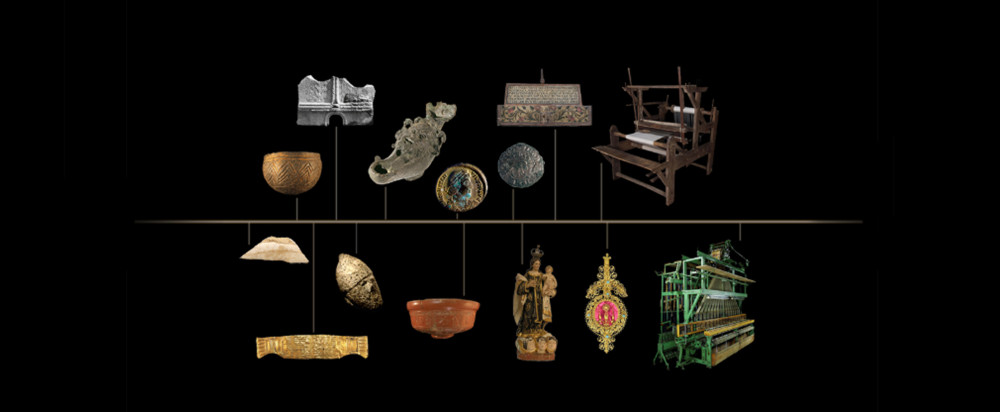City Council /
Vila Nova de Famalicão
History

A Land with Future, Past and Present
The historical remains of the origins of the settlement on this land, takes us to the Iron Age, more precisely to archaeological remains of castros locally. The Castro of Monte das Ermidas, perhaps founded in the 4th century BC, the Castro of São Miguel-o-Anjo (St Michael the Angel) or the Castro of Eiras, are some of the archaeological remains of remote settlements that exist locally. The Formosa Stone of Eiras Castro, which was part of a public bath complex, was found in 1880, and, according to archaeologists, dates from the first millennium BC.
On 1st July 1205, King D. Sancho I of Portugal who had a royal village in Vila Nova, sent a charter letter to 40 villagers of that land, giving them permission to make use of his land. All the profits that the forty people made under this agreement would be perpetually theirs, by hereditary right, and they could freely sell to whom they wished. Thus, the history of the village as a community begins from that moment. In this same charter letter, the king orders the village to hold a fortnightly fair, a tradition that is still followed weekly today.
Vila de Famalicão, as Head of the Judicial Division of Vermoim, began to appreciate over the years, so much so that in 1706 it had 100 native inhabitants. In 1734 and 1735, yearning for more progress, it demanded more benefits and privileges from Barcelos.
On 21st March 1835, with the creation of the new Judicial Division of the Kingdom of Portugal, the municipality of Vila Nova de Famalicão was formed by Charter letter from Queen D. Maria II, gaining, hence, its political autonomy.
In the second half of the twentieth century, the town had reached a high level of quality of life, with modern amenities and infrastructure. Such progress could lead the town to be considered as a city. Thus, the Law of 14th August 1985, adopted earlier by Parliament on 9th July 1985, paved the way for Vila Nova de Famalicão’s rise to the category of a city.
Throughout its long history, Vila Nova de Famalicão has often been mentioned as one of the main cultural, commercial and industrial centres in Portugal. And today it continues to assert itself in the country as one of the cities that most contributes to Portugal being acknowledged in the World.
This is where Camilo Castelo Branco chose to live and produce most of his literary works, becoming the greatest Portuguese language novelist.
Other personalities had found in Vila Nova de Famalicão their home or fertile grounds for their personal achievements. This is the case of Bernardino Machado, Arthur Cupertino de Miranda or Alberto Sampaio. To these names should be added a multitude of people from Famalicão that turned the city into a place of reference.
On 1st July 1205, King D. Sancho I of Portugal who had a royal village in Vila Nova, sent a charter letter to 40 villagers of that land, giving them permission to make use of his land. All the profits that the forty people made under this agreement would be perpetually theirs, by hereditary right, and they could freely sell to whom they wished. Thus, the history of the village as a community begins from that moment. In this same charter letter, the king orders the village to hold a fortnightly fair, a tradition that is still followed weekly today.
Vila de Famalicão, as Head of the Judicial Division of Vermoim, began to appreciate over the years, so much so that in 1706 it had 100 native inhabitants. In 1734 and 1735, yearning for more progress, it demanded more benefits and privileges from Barcelos.
On 21st March 1835, with the creation of the new Judicial Division of the Kingdom of Portugal, the municipality of Vila Nova de Famalicão was formed by Charter letter from Queen D. Maria II, gaining, hence, its political autonomy.
In the second half of the twentieth century, the town had reached a high level of quality of life, with modern amenities and infrastructure. Such progress could lead the town to be considered as a city. Thus, the Law of 14th August 1985, adopted earlier by Parliament on 9th July 1985, paved the way for Vila Nova de Famalicão’s rise to the category of a city.
Throughout its long history, Vila Nova de Famalicão has often been mentioned as one of the main cultural, commercial and industrial centres in Portugal. And today it continues to assert itself in the country as one of the cities that most contributes to Portugal being acknowledged in the World.
This is where Camilo Castelo Branco chose to live and produce most of his literary works, becoming the greatest Portuguese language novelist.
Other personalities had found in Vila Nova de Famalicão their home or fertile grounds for their personal achievements. This is the case of Bernardino Machado, Arthur Cupertino de Miranda or Alberto Sampaio. To these names should be added a multitude of people from Famalicão that turned the city into a place of reference.

